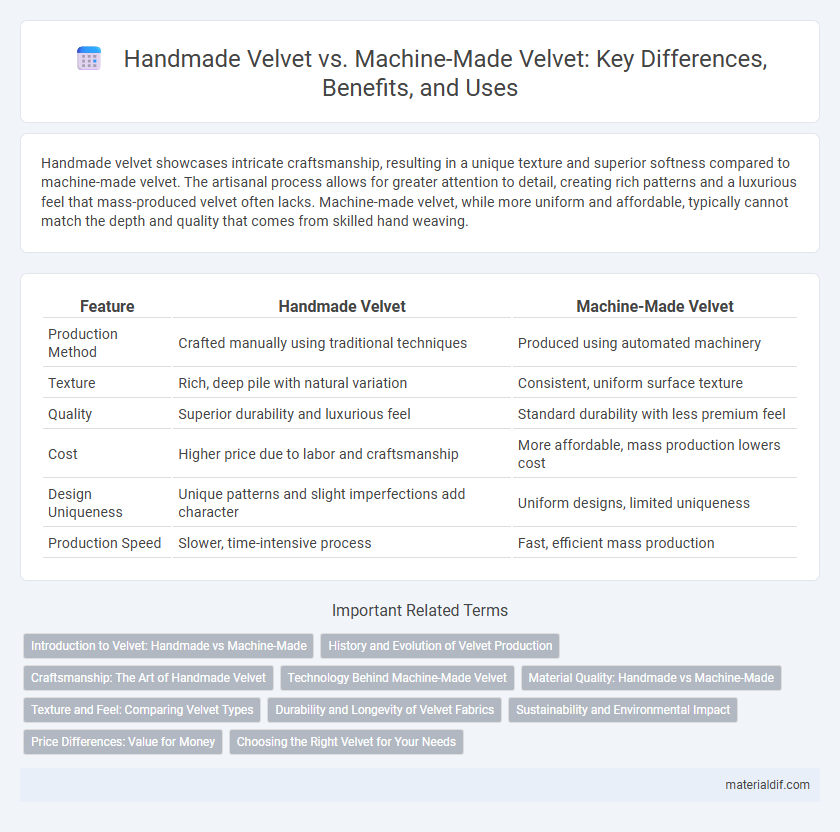Handmade velvet showcases intricate craftsmanship, resulting in a unique texture and superior softness compared to machine-made velvet. The artisanal process allows for greater attention to detail, creating rich patterns and a luxurious feel that mass-produced velvet often lacks. Machine-made velvet, while more uniform and affordable, typically cannot match the depth and quality that comes from skilled hand weaving.
Table of Comparison
| Feature | Handmade Velvet | Machine-Made Velvet |
|---|---|---|
| Production Method | Crafted manually using traditional techniques | Produced using automated machinery |
| Texture | Rich, deep pile with natural variation | Consistent, uniform surface texture |
| Quality | Superior durability and luxurious feel | Standard durability with less premium feel |
| Cost | Higher price due to labor and craftsmanship | More affordable, mass production lowers cost |
| Design Uniqueness | Unique patterns and slight imperfections add character | Uniform designs, limited uniqueness |
| Production Speed | Slower, time-intensive process | Fast, efficient mass production |
Introduction to Velvet: Handmade vs Machine-Made
Handmade velvet features meticulously crafted pile created by skilled artisans, resulting in a rich texture and unique variations that showcase craftsmanship quality. Machine-made velvet is produced using automated looms, offering consistent patterns and faster production suitable for mass markets. Differences in durability, softness, and cost stem from the distinct manufacturing techniques used in handmade versus machine-made velvet.
History and Evolution of Velvet Production
Handmade velvet, originating in the Middle Ages, was crafted on handlooms with intricate techniques requiring significant time and skill, contributing to its luxury status among nobility. The Industrial Revolution introduced machine-made velvet, revolutionizing production by increasing speed and accessibility while maintaining the fabric's distinctive plush texture. This evolution from artisanal craftsmanship to mechanized manufacturing reflects broader advancements in textile technology and changing consumer demands over centuries.
Craftsmanship: The Art of Handmade Velvet
Handmade velvet showcases unparalleled craftsmanship, characterized by intricate weaving techniques that create a rich texture and depth unmatched by machine-made velvet. Artisans meticulously control each thread, ensuring a luster and softness that reflect centuries-old traditions and superior quality. This dedication to detail results in a fabric prized for its uniqueness and durability, making handmade velvet a luxurious choice for high-end fashion and interior design.
Technology Behind Machine-Made Velvet
Machine-made velvet is produced using advanced weaving technologies such as automated jacquard looms and computerized cutting machines, which enhance precision and consistency in pile height and texture. This technology enables faster production rates and uniform fabric quality compared to the labor-intensive hand weaving process. Innovations in synthetic fiber integration further improve the durability and elasticity of machine-made velvet, making it a preferred choice for commercial textile manufacturing.
Material Quality: Handmade vs Machine-Made
Handmade velvet features natural fibers like silk and cotton, resulting in superior texture, durability, and luxurious softness compared to machine-made velvet, which often uses synthetic blends. The painstaking craftsmanship in handmade velvet ensures consistent pile height and richer color depth, while machine-made velvet may have less uniformity and lower resistance to wear. High-end fashion and upholstery prioritize handmade velvet for its unmatched material quality and authentic tactile appeal.
Texture and Feel: Comparing Velvet Types
Handmade velvet features a richer, more luxurious texture due to the meticulous craftsmanship that creates denser, softer pile, resulting in a smoother and more supple feel. Machine-made velvet often has a uniform texture with a slightly stiffer hand, which can lack the depth and variation found in handmade versions. The tactile distinction is evident, as handmade velvet provides a more plush and organic sensation, ideal for high-end upholstery and garments requiring a premium touch.
Durability and Longevity of Velvet Fabrics
Handmade velvet exhibits superior durability and longevity due to its meticulous weaving process, which creates denser, more resilient fibers that withstand wear better than machine-made equivalents. Machine-made velvet, while more uniform and cost-effective, often compromises on fiber strength and elasticity, leading to quicker fabric degradation under frequent use. High-quality handmade velvet maintains its plush texture and vibrant color for years, making it the preferred choice for luxurious upholstery and garments requiring long-lasting performance.
Sustainability and Environmental Impact
Handmade velvet production features lower energy consumption and reduced chemical use, contributing to a smaller environmental footprint compared to machine-made velvet. Artisanal techniques often involve natural dyes and sustainable fibers, enhancing the fabric's eco-friendly attributes. In contrast, machine-made velvet typically relies on synthetic materials and intensive industrial processes, leading to higher pollution and waste generation.
Price Differences: Value for Money
Handmade velvet typically commands a higher price due to its intricate craftsmanship and use of premium materials, offering superior texture and durability compared to machine-made velvet. Machine-made velvet is more affordable, produced at scale with automated processes, but often lacks the rich, nuanced finish found in handmade variants. Consumers seeking long-term value may find handmade velvet justifies the initial investment through enhanced quality and timeless appeal.
Choosing the Right Velvet for Your Needs
Handmade velvet offers superior texture and durability due to its intricate craftsmanship, making it ideal for luxury upholstery and high-end fashion where quality is paramount. Machine-made velvet provides greater affordability and consistency, suitable for large-scale production and everyday apparel. Selecting the right velvet depends on balancing budget constraints with the desired level of texture richness and longevity.
Handmade Velvet vs Machine-Made Velvet Infographic

 materialdif.com
materialdif.com